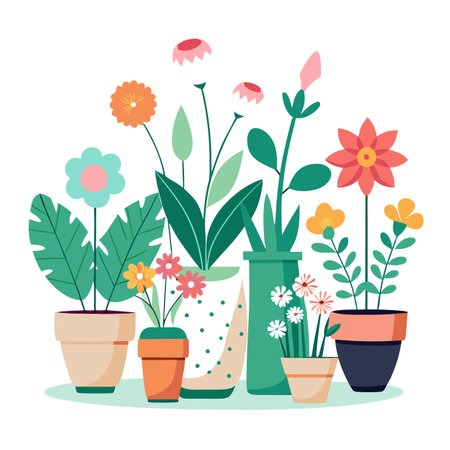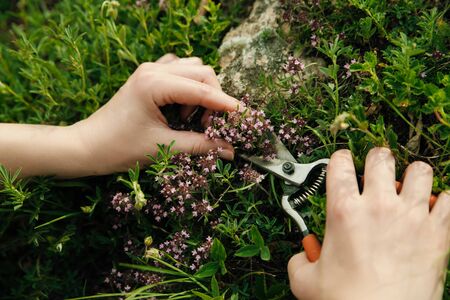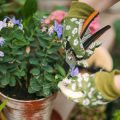Introduction to Companion Planting in Cut Flower Gardens
Companion planting is a time-honored gardening method that brings together plants with complementary characteristics, creating a thriving and resilient ecosystem right in your backyard. For American home gardeners who love growing cut flowers, companion planting isnt just about making the most of your garden space—its about nurturing a vibrant, sustainable environment that supports pollinators, reduces pests naturally, and enriches soil health. By thoughtfully pairing flowers and beneficial plants, you foster biodiversity and minimize the need for synthetic chemicals, aligning your garden practices with eco-friendly values. Whether youre an urban gardener or tending a rural plot, embracing companion planting in your cut flower beds helps conserve resources, protect local wildlife, and ensure that every bouquet you gather is both beautiful and responsibly grown.
Top Companion Plant Pairings for Vibrant Blooms
When it comes to companion planting in American cut flower gardens, some plant partnerships are simply classic. These combinations not only support healthier blooms but also attract essential pollinators and beneficial insects, helping you cultivate a thriving, eco-friendly garden. Here are some tried-and-true pairings that consistently deliver stunning results and align with sustainable gardening values.
Classic U.S. Companion Flower Pairings
| Flower | Ideal Companion(s) | Benefits |
|---|---|---|
| Zinnias (native cultivars) | Basil, Cosmos | Basil deters pests; Cosmos attracts bees & butterflies, boosting pollination. |
| Sunflowers (Helianthus annuus) | Cornflowers, Snapdragons | Sunflowers provide natural trellises; companions attract pollinators and deter aphids. |
| Dahlias | Lavender, Marigolds | Lavender repels moths; Marigolds suppress nematodes and attract beneficial insects. |
| Echinacea (Coneflower) | Black-Eyed Susan, Bee Balm | Both native; together they create pollinator havens and resist drought conditions. |
| Sweet Peas | Nasturtiums, Calendula | Nasturtiums act as a trap crop for aphids; Calendula attracts ladybugs and lacewings. |
Pollinator-Friendly & Native Combinations
Purple Coneflower & Bee Balm: Both being North American natives, this duo is a magnet for native bees, butterflies, and hummingbirds. They thrive in similar soil and light conditions, making them low-maintenance yet high-impact for biodiversity.
Zinnias & Cosmos: These annual favorites grow well together and bloom throughout the summer. Their abundance of pollen and nectar supports monarchs, swallowtails, and local bee populations.
Sunflowers & Cornflowers: This sunny pairing offers structural diversity—sunflowers shoot up tall while cornflowers fill in around their bases. Both are beloved by pollinators like bumblebees and goldfinches.
Tips for Maximizing Companion Success
- Diversity is Key: Planting a variety of species mimics natural ecosystems, supporting more pollinators and reducing pest outbreaks without chemicals.
- Select Natives When Possible: Native species are better adapted to local climates and support indigenous wildlife.
- Rotate Annually: Change up your pairings each year to prevent soil-borne diseases and keep your garden ecosystem resilient.
- Avoid Overcrowding: Give each plant space to ensure good airflow—a simple step for healthier stems and longer-lasting blooms in your cut flower arrangements.
Sustainable Takeaway
The best companion plant pairings aren’t just about gorgeous bouquets—they’re about cultivating a balanced garden ecosystem right in your backyard. Embrace these combinations to nurture both beauty and biodiversity, all while supporting pollinators essential to American landscapes. By working with nature through thoughtful pairing, your cut flower garden will flourish season after season.

3. Eco-Friendly Pest Management through Companion Planting
One of the greatest benefits of companion planting in cut flower gardens is its ability to naturally keep pests at bay, minimizing the need for synthetic pesticides. By thoughtfully pairing specific flowers and herbs, gardeners can create a self-sustaining ecosystem where plants support each other’s health. For example, marigolds are famous for their pest-repelling properties; when planted near zinnias or dahlias, they help deter aphids and nematodes that often attack these blooms. Similarly, aromatic herbs like basil and mint not only add fragrance but also confuse pests such as thrips and whiteflies, keeping them away from delicate blossoms.
This eco-friendly approach does more than just reduce chemical use—it encourages biodiversity by attracting beneficial insects like ladybugs and lacewings that naturally control pest populations. These “good bugs” thrive in gardens with diverse plant groupings, creating a balanced environment where harmful pests are less likely to cause damage. By integrating these natural allies into your cut flower beds, you’re supporting pollinators, protecting soil health, and fostering a resilient landscape that reflects the American values of stewardship and sustainability. Ultimately, companion planting transforms your garden into a vibrant, living system where beauty and environmental responsibility flourish side by side.
4. Enhancing Soil Health and Sustainability
One of the greatest benefits of companion planting in cut flower gardens is its positive impact on soil health and long-term sustainability. By carefully selecting plant partnerships, gardeners can not only beautify their plots but also nurture the earth beneath them—an essential principle in regenerative gardening. Let’s explore which strategies best improve soil fertility, minimize erosion, and foster robust root systems for thriving blooms year after year.
Soil Fertility Boosters
Some flowers, when grown together with specific companion plants, can naturally enrich the soil without synthetic fertilizers. For example, legumes like sweet peas fix nitrogen from the air and release it into the soil, benefiting heavy-feeding cut flowers such as dahlias or sunflowers planted nearby. Likewise, marigolds are known to suppress harmful nematodes and promote beneficial microbes, creating a healthier environment for bulb flowers like lilies and tulips.
| Flower | Companion Plant | Benefit |
|---|---|---|
| Dahlia | Sweet Pea (Legume) | Nitrogen Fixation for Lush Growth |
| Lily | Marigold | Pest Suppression & Soil Microbe Support |
| Zinnia | Basil | Improved Pollination & Disease Resistance |
Minimizing Erosion Through Strategic Planting
Erosion is a common concern in American gardens, especially on sloped beds or in regions prone to heavy rainfall. Companion planting helps by utilizing dense ground covers like alyssum or low-growing herbs such as thyme between taller cut flowers. These companions create a living mulch that shields soil from wind and water runoff while reducing weed pressure—critical for maintaining healthy garden beds season after season.
Top Ground Cover Companions for Cut Flowers:
- Alyssum: Fast-growing cover that attracts pollinators and holds soil in place.
- Creeping Thyme: Aromatic herb that forms a dense mat under taller stems.
- Clover: Nitrogen-fixer that suppresses weeds and stabilizes soil structure.
Encouraging Healthy Root Systems with Biodiversity
Diverse plantings encourage roots to grow deeper and stronger by reducing competition for the same nutrients. Combining tap-rooted species like cosmos with shallow-rooted companions such as calendula ensures efficient use of resources below ground. This fosters resilience against drought and disease while aligning with regenerative practices focused on building living soils for future generations.
Sustainable Takeaway:
The most effective companion planting strategies for cut flower gardens are those that mimic natural ecosystems—layering plants with varying root depths, incorporating legumes for nutrient cycling, and using ground covers to protect and enhance the soil. By embracing these methods, American gardeners can cultivate not just beautiful bouquets but also a more sustainable relationship with the land itself.
5. Cultural Considerations: Reflecting Local Biodiversity
When planning a companion planting strategy for your cut flower garden, it’s essential to embrace the rich tapestry of America’s local biodiversity. By selecting regionally appropriate plants, you not only honor the unique ecological heritage of your community but also create a more resilient and sustainable garden. Native flowers like Black-eyed Susans in the Midwest, California poppies on the West Coast, or Coneflowers in the South are excellent choices for supporting pollinators and beneficial insects indigenous to your area. Integrating these plants with classic cut flower varieties can enhance visual appeal while encouraging healthy ecosystems.
Encouraging Regional Adaptation
American gardeners have long valued the practice of “right plant, right place.” By choosing species that are well-suited to your USDA hardiness zone and local climate, you reduce the need for chemical inputs, minimize water use, and create habitats that benefit local wildlife such as butterflies, bees, and birds. Consult local extension offices or native plant societies for advice on what thrives best in your region.
Community Traditions and Shared Values
Companion planting is deeply rooted in American gardening traditions—think of Three Sisters gardens cultivated by Indigenous peoples, where corn, beans, and squash are grown together for mutual benefit. Today’s cut flower gardeners can carry on this legacy by pairing sunflowers with zinnias or marigolds with cosmos, combinations that not only look beautiful in a vase but also help support soil health and pest management naturally.
Supporting Local Wildlife
By weaving together native flowers and classic cut blooms in your garden beds, you provide crucial resources for pollinators and other wildlife struggling amid habitat loss. Planting milkweed alongside asters or goldenrod attracts monarch butterflies, while interspersing yarrow or bee balm can boost populations of native bees. These practices don’t just result in healthier gardens—they contribute to broader conservation efforts across American landscapes.
Ultimately, reflecting local biodiversity through thoughtful companion planting celebrates both environmental stewardship and cherished gardening traditions, ensuring our cut flower gardens flourish for generations to come.
6. Tips for Designing Your Sustainable Cut Flower Garden
Creating a cut flower garden that thrives on companion planting and sustainable practices is both rewarding and eco-friendly. Start by mapping out your garden space, keeping in mind the sunlight, soil quality, and moisture levels needed for your chosen flowers and their companions. Group plants with similar needs together to minimize water waste and reduce the need for chemical inputs.
Plan with Purpose
Select native or well-adapted flower varieties to support local pollinators and resilience against pests. Pair these with herbs like basil, dill, or mint, which naturally deter common pests while attracting beneficial insects. Rotate crops annually to keep soil healthy and avoid disease build-up.
Planting Techniques
Interplant tall growers such as sunflowers or cosmos with lower-growing companions like sweet alyssum or calendula. This not only maximizes space but also creates layers of habitat for pollinators and natural pest control. Use organic mulch around plant bases to retain moisture, suppress weeds, and feed your soil as it breaks down.
Maintenance Matters
Commit to regular, mindful maintenance by hand-picking pests instead of reaching for chemicals. Water deeply but infrequently to encourage strong root systems and conserve resources. Compost spent blooms and plant trimmings right back into your garden beds for a closed-loop system that reduces waste.
Eco-Conscious Upgrades
Incorporate rain barrels or drip irrigation to further reduce water use. Choose biodegradable twine and upcycled stakes for supporting taller stems. Finally, keep records of what grows well together in your unique microclimate—this will help you refine your companion planting strategy year after year, making your cut flower garden more resilient and sustainable with each season.


